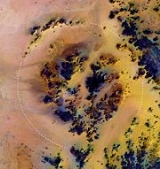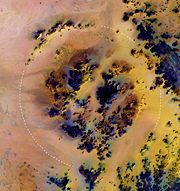
Kebira Crater
Encyclopedia

Sahara
The Sahara is the world's second largest desert, after Antarctica. At over , it covers most of Northern Africa, making it almost as large as Europe or the United States. The Sahara stretches from the Red Sea, including parts of the Mediterranean coasts, to the outskirts of the Atlantic Ocean...
desert. The center of the feature lies in Libya
Libya
Libya is an African country in the Maghreb region of North Africa bordered by the Mediterranean Sea to the north, Egypt to the east, Sudan to the southeast, Chad and Niger to the south, and Algeria and Tunisia to the west....
, and the eastern edge extends into Egypt
Egypt
Egypt , officially the Arab Republic of Egypt, Arabic: , is a country mainly in North Africa, with the Sinai Peninsula forming a land bridge in Southwest Asia. Egypt is thus a transcontinental country, and a major power in Africa, the Mediterranean Basin, the Middle East and the Muslim world...
. Its discovery from satellite images
Satellite imagery
Satellite imagery consists of photographs of Earth or other planets made by means of artificial satellites.- History :The first images from space were taken on sub-orbital flights. The U.S-launched V-2 flight on October 24, 1946 took one image every 1.5 seconds...
was announced in March 2006 by researchers Dr. Farouk El-Baz
Farouk El-Baz
Farouk El-Baz is an Egyptian American scientist who worked with NASA to assist in the planning of scientific exploration of the Moon, including the selection of landing sites for the Apollo missions and the training of astronauts in lunar observations and photography.Currently, El-Baz is Research...
and Dr. Eman Ghoneim
Eman Ghoneim
Dr. Eman Ghoneim is an experienced Egyptian geomorphologist with a primary focus on the application of Geographical Information Systems , Remote Sensing and the use of Hydrologic modeling in Flash flood hazard and Groundwater exploration in arid environments.During her research, she uses satellite...
from the Center for Remote Sensing
Remote sensing
Remote sensing is the acquisition of information about an object or phenomenon, without making physical contact with the object. In modern usage, the term generally refers to the use of aerial sensor technologies to detect and classify objects on Earth by means of propagated signals Remote sensing...
at Boston University
Boston University
Boston University is a private research university located in Boston, Massachusetts. With more than 4,000 faculty members and more than 31,000 students, Boston University is one of the largest private universities in the United States and one of Boston's largest employers...
, who proposed that it may be an eroded impact crater
Impact crater
In the broadest sense, the term impact crater can be applied to any depression, natural or manmade, resulting from the high velocity impact of a projectile with a larger body...
(astrobleme). They suggested that the crater's original appearance has been obscured by wind and water erosion
Erosion
Erosion is when materials are removed from the surface and changed into something else. It only works by hydraulic actions and transport of solids in the natural environment, and leads to the deposition of these materials elsewhere...
over time. Detailed field work would be required in order to test the impact hypothesis.
Characteristics
The feature has two rings, the outer of which is 31 kilometres (19 mi) in diameter. If it is an impact crater, it is bigger than the largest confirmed impact crater in the region, the Oasis craterOasis crater
Oasis is a meteorite crater in Libya. The crater is exposed at the surface, and has been significantly eroded. The prominent topographic ring is only the central uplift, while the original crater rim is estimated to have been 18 km in diameter. The age is estimated to be less than 120 million...
in Libya, which is approximately half the size, with a diameter of approximately 18 kilometres (11 mi). It is estimated that a meteorite
Meteorite
A meteorite is a natural object originating in outer space that survives impact with the Earth's surface. Meteorites can be big or small. Most meteorites derive from small astronomical objects called meteoroids, but they are also sometimes produced by impacts of asteroids...
large enough to have created a Kebira-sized crater would have been roughly 1 kilometre (0.75 mi) in diameter. As of 2007, the date of the putative impact had not been determined, but it was speculated that it may be related to the yellow-green silica
Silicon dioxide
The chemical compound silicon dioxide, also known as silica , is an oxide of silicon with the chemical formula '. It has been known for its hardness since antiquity...
glass fragments, known as "Libyan desert glass
Libyan desert glass
Libyan desert glass , or great sand sea glass is a substance found in areas in the Libyan Desert. Fragments of desert glass can be found over large areas, up to tens of kilometers.- Geologic origin :...
", that can be found across part of Egypt's Libyan Desert
Libyan Desert
The Libyan Desert covers an area of approximately 1,100,000 km2, it extends approximately 1100 km from east to west, and 1,000 km from north to south, in about the shape of a rectangle...
.
There have been skeptical reactions to the news reports because it is based on speculation about remote sensing data. The Impact Field Studies Group
Impact Field Studies Group
The Impact Field Studies Group is a scientific organization emphasizing geologic field research of suspected and confirmed sites of impact craters and impact structures. The group is composed of researchers, professionals and students involved in study of impact sites...
's Impact Database (formerly Suspected Earth Impact Sites, SEIS) list rates this as improbable for an impact origin. The catalog notes that the observed circular area was visible in Google Earth as having a flat top in the center, indicating similar geology to the surrounding area. An impact site should be an isolated area of different geology from its surroundings.
Etymology
The name of the purported crater is derived from the Arabic word for "large", and also from its location near the Gilf KebirGilf Kebir
Gilf Kebir is a plateau in the New Valley Governorate of the remote southwest corner of Egypt, and southeast Libya. Its name translates as "the Great Barrier"...
("Great Barrier") region in southwest Egypt.
Status
The possible crater was first announced in early March 2006. Several people quickly responded to the announcement by arranging to travel to the site. Two such scientists arrived in Libya in March, and later published their findings: "[C]ontinued north . . towards a large circular feature that was recently announced to be an 'impact crater' . . We drove past the 'central uplift' along its western edge, then drove into the central part. It is evident, that what is considered the 'central uplift' is in fact nothing more than an eroded outlier of the Gilf, the undisturbed horizontal bedding being clearly visible at all times. The circular shape appears to be pure coincidence, the whole feature is the result of drainage patterns and subsequent eolian erosion, there is nothing to suggest its impact origin." And "We were now in the crater area, looking at the western edge of the central uplift area of the 'crater'. What we saw were uniform horizontal layers of sedimentary rocks, undisturbed except by the processes of natural erosion. The jumbled, chaotic rock formation that we would expect to see in the central uplift area of a crater was not evident at all."A study published in Science reported a field investigation of the Kebira Crater area. After analyzing the presence/absence of several geologic features associated with impact craters, such as target rocks, breccias, pseudo-shatter cones, and circular morphology, the authors concluded: "[T]here are [sic] no clear and unequivocal evidence supporting the impact origin of the circular structures in Glif Kebir region; until substantial evidence is produced, it's necessary to identify the origin of the craters in others [sic] endogenic geological processes." They proposed the most likely alternative source of the crater to be a hydrothermal vent, although they went on to say: "However, even this hypothesis is not fully satisfactory: probably these complex and peculiar features are the result of interaction between different geological process. At present, this hypothesis cannot be completely constrained; further investigations are necessary. Anyway, the lacking of clear evidences of a meteoritic impact and the geological framework of the investigated area, lead us to confirm the hydrothermal-volcanic hypothesis."
External links
- News Release (Boston UniversityBoston UniversityBoston University is a private research university located in Boston, Massachusetts. With more than 4,000 faculty members and more than 31,000 students, Boston University is one of the largest private universities in the United States and one of Boston's largest employers...
, 3 March 2006) - Huge Crater Found in Egypt (Space.comSpace.comSpace.com is a space and astronomy news website. Its stories are often syndicated to other media outlets, including CNN, MSNBC, Yahoo!, and USA Today.Space.com was founded by former CNN anchor Lou Dobbs and Rich Zahradnik, in July 1999...
, 3 March 2006) - Huge impact crater found in Egypt (BBC NewsBBC NewsBBC News is the department of the British Broadcasting Corporation responsible for the gathering and broadcasting of news and current affairs. The department is the world's largest broadcast news organisation and generates about 120 hours of radio and television output each day, as well as online...
, 6 March 2006) - M. Di Martino, et. al., Non-impact origin of the crater field in the Gilf Kebir region (SW Egypt). 2007?, 48pp.(PDF). More here
- Norbert Brügge, Remarks to the origin of the craters around Gilf Kebir and Djebel Uweinat (Egypt)and the supposed impact craters of Libya. December 2004. (Last update 3.12.2009)]

